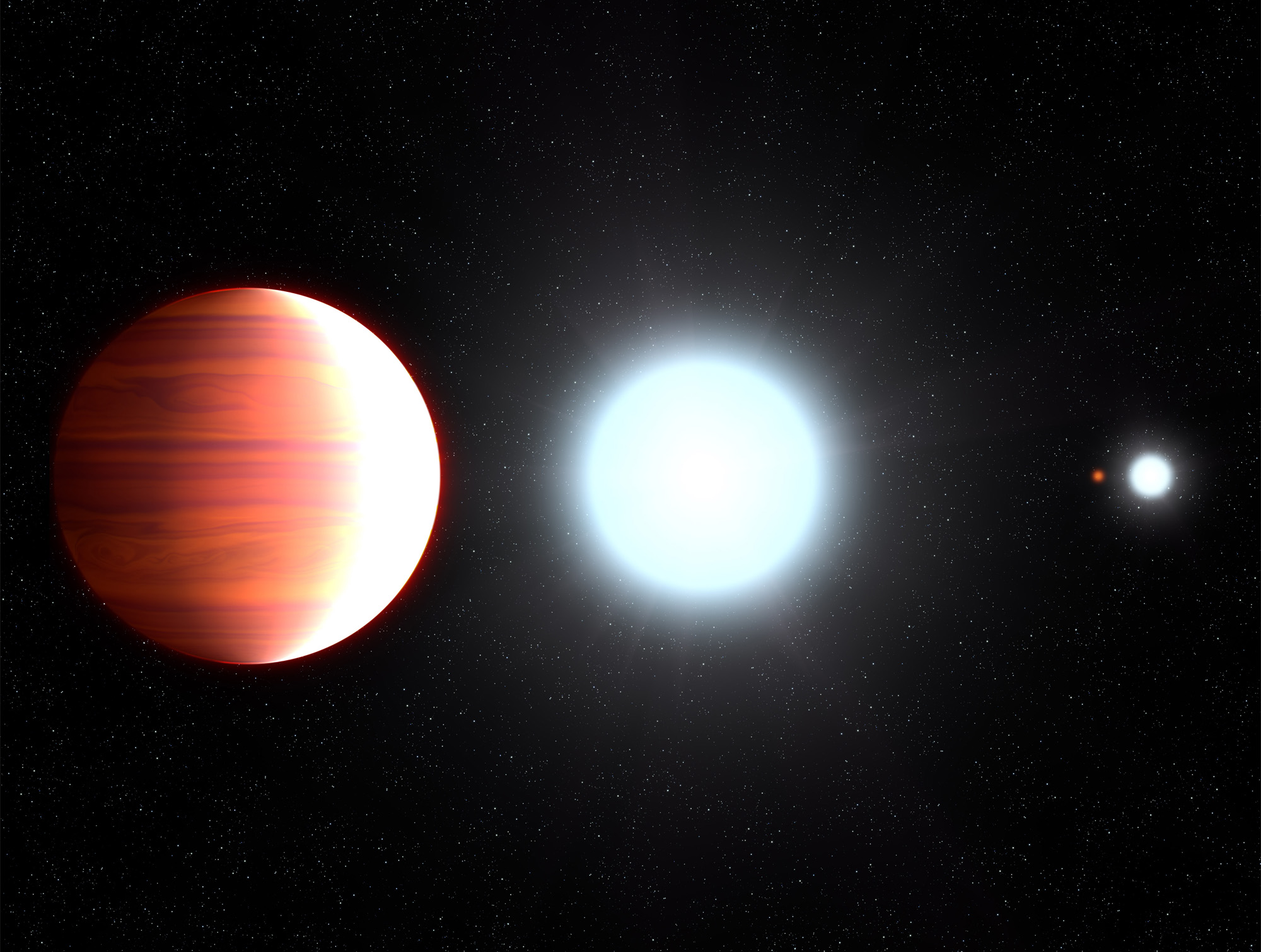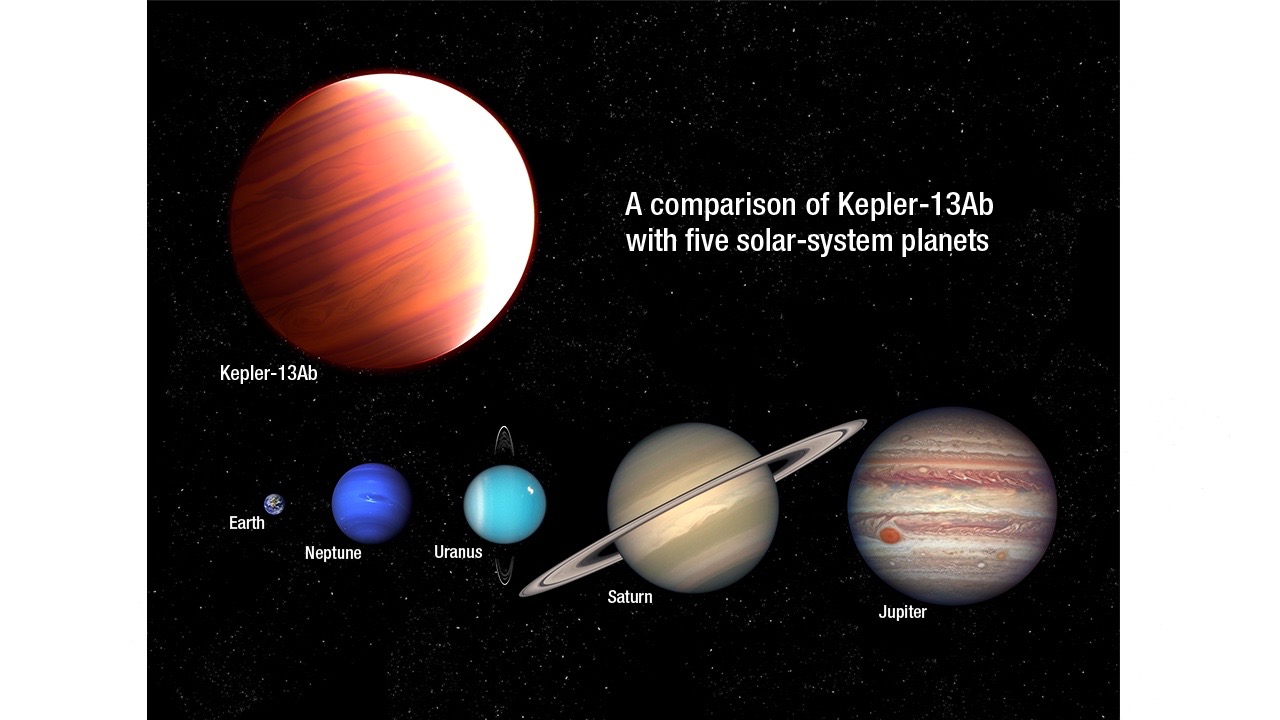Sunscreen 'Snow' Falls on Scorching-Hot Alien Planet

The weirdness of exoplanets continues to amaze.
It snows titanium dioxide, one of the active ingredients in sunscreen, on one giant, scorching-hot alien world, a new study suggests.
Astronomers used NASA's Hubble Space Telescope to study Kepler-13Ab, a planet that's six times more massive than Jupiter and that lies 1,730 light-years from Earth. [Hubble in Pictures: Astronomers' Top Picks (Photos)]
Kepler-13Ab is very close to its host star, completing one orbit every 1.8 Earth days. As a result, the planet is one of the hottest worlds known, with a dayside temperature of nearly 5,000 degrees Fahrenheit (2,760 degrees Celsius), researchers said. (Like many other tightly orbiting worlds, Kepler-13Ab is "tidally locked," always showing the same face to its star. So, it has a dayside and a nightside.)

The Hubble observations showed that temperatures higher up in Kepler-13Ab's atmosphere are cooler than those below — a surprising result, given that other "hot Jupiter" exoplanets tend to display the opposite pattern.
On most hot Jupiters, gaseous titanium dioxide in the dayside's upper atmosphere absorbs starlight and radiates this energy as heat, warming the air up. So, what's going on with Kepler-13Ab? The study team thinks that strong winds carry the planet's titanium dioxide around to the nightside, where the stuff cools and condenses into clouds. These clouds then drop the sunscreen "snow" into the lower atmosphere, where it stays, thanks to Kepler-13Ab's powerful gravity.
"These observations of Kepler-13Ab are telling us how condensates and clouds form in the atmospheres of very hot Jupiters, and how gravity will affect the composition of an atmosphere," study lead author Thomas Beatty, an assistant research professor of astronomy at Pennsylvania State University, said in a statement. "When looking at these planets, you need to know not only how hot they are, but also what their gravity is like."
Get the Space.com Newsletter
Breaking space news, the latest updates on rocket launches, skywatching events and more!
The "cold trap" process invoked for Kepler-13Ab had never been seen in action on an exoplanet before, researchers said.
The new study, which was published in the October 2017 issue of The Astronomical Journal, could eventually help astronomers better understand exoplanets more like our own, Beatty added.
"In many ways, the atmospheric studies we're doing now on these gaseous, 'hot Jupiter' kinds of planets are test beds for how we're going to do atmospheric studies of terrestrial, Earth-like planets," he said in the same statement. "Understanding more about the atmospheres of these planets and how they work will help us when we study smaller planets that are harder to see and have more-complicated features in their atmospheres."
As its name suggests, Kepler-13Ab was discovered by NASA's planet-hunting Kepler space telescope, back in 2011. The planet is part of a triple-star system that includes the hot Jupiter's host star, Kepler-13A, and two companion stars (Kepler-13B and Kepler-13C).
Follow Mike Wall on Twitter @michaeldwall and Google+. Follow us @Spacedotcom, Facebook or Google+. Originally published on Space.com.
Join our Space Forums to keep talking space on the latest missions, night sky and more! And if you have a news tip, correction or comment, let us know at: community@space.com.

Michael Wall is a Senior Space Writer with Space.com and joined the team in 2010. He primarily covers exoplanets, spaceflight and military space, but has been known to dabble in the space art beat. His book about the search for alien life, "Out There," was published on Nov. 13, 2018. Before becoming a science writer, Michael worked as a herpetologist and wildlife biologist. He has a Ph.D. in evolutionary biology from the University of Sydney, Australia, a bachelor's degree from the University of Arizona, and a graduate certificate in science writing from the University of California, Santa Cruz. To find out what his latest project is, you can follow Michael on Twitter.









